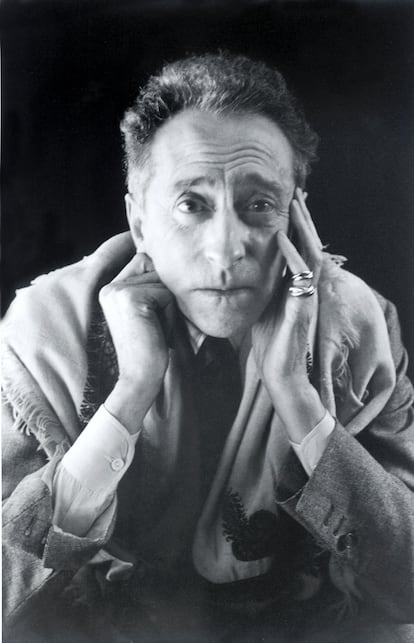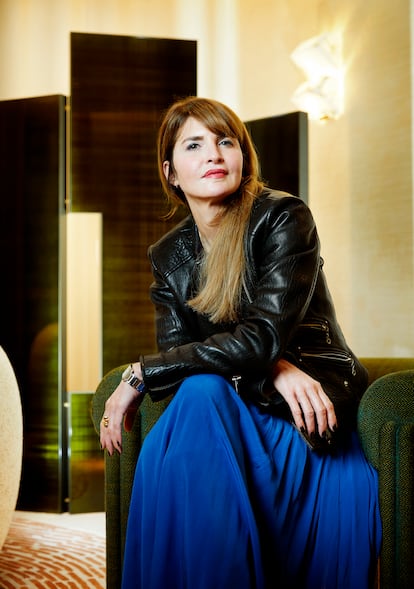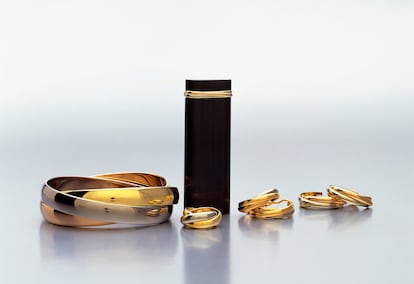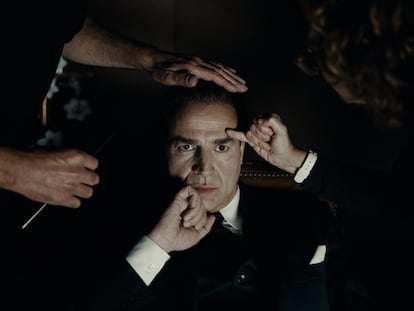Gen Z falls in love with the ring with which French poet Jean Cocteau declared his passion to his lover
The Trinity de Cartier ring, made up of three gold bands, intertwined to infinity, is one of the most iconic pieces of contemporary jewelry

The appointment with Marie-Laure Cérède, Cartier’s creative director of watches and jewelry, is in an apartment at the top of an elegant building located on Avenue Bosquet, in Paris. Before going up, you have to announce yourself to a security guard. The mere presence of this uniformed man confirms that, at the top of this building, between the Champ de Mars and Les Invalides, there is a secret (or a treasure) that must be guarded.
Inside the apartment, there are more men in black. In one of the rooms — with huge windows from which you can see the Eiffel Tower in all its majesty — there’s a grand piano and, above it, silver frames displaying photographs of Gary Cooper, Alain Delon, Romy Schneider, Jacqueline Bisset, Grace Kelly and other iconic actors. It’s easy to see that each of these stars wore one of Cartier’s most iconic pieces on their ring finger: the Trinity ring, with three rings intertwined to infinity.
Louis Cartier, grandson of the founder of the Cartier luxury brand, designed the Trinity ring in 1924, thinking about the number three. Since ancient times, it’s considered to be the perfect number. The three rings in one, which revolutionized the jewelry business 100 years ago, referred to Louis and his two brothers, Pierre and Jacques, heirs to the buoyant empire founded by their grandfather. The three rings also reference the three stores that the firm had at the time, in Paris, London and New York City.
The ring also materialized a concept that’s now very popular: diversity. Three different elements — a gilt gold band, a rose gold band and a white gold band — come together and harmoniously form a unit. The Trinity, which is celebrating a century of life, has become a symbol of love in all its forms: filial, family, friendly and marital. It’s one of the most-requested models among customers who wish to declare their love for someone… or for themselves.

“Generally, each Cartier piece begins with a handmade drawing. In this case, the starting point was an object that already has a lot of history and is already perfect. Because Trinity is perfect: three bands in one and one in three, a celebration of the concept of inclusion,” explains Cérède, after welcoming EL PAÍS into one of the rooms of this Parisian apartment.
In front of her, the new Trinity collection is displayed: rings, XL bracelets and pendants. The creative director of the jewelry house began working on this project two years ago, with the idea of commemorating the centenary of the original line. She made more than 50 prototypes. “I actually lost count of how many attempts we made. We had no obligation to carry out this new collection. If the final result wasn’t good or didn’t convince us, we weren’t going to release it. But there was a lot of pressure, because we were working with an iconic object,” she acknowledges.
Cérède began her career at Cartier in 2002. After spending almost 12 years at Harry Winston, she returned to the French house. In 2017, she was promoted to the top position in design, ultimately becoming responsible for the esthetics of all Cartier watches and jewelry pieces. She knows the history of the house well and — as is often the case — she began this new collection by visiting the archives. “I always come back to them. Part of my job is to have a deep understanding of the brand’s heritage. And another part is seeing that legacy with fresh eyes. We wanted something new… we didn’t know what, but we wanted something new,” she affirms.

It’s difficult to reinvent the wheel (or, rather, the circle), but Cérède has achieved it by playing with sizes, volumes and shapes, such as larger and maximalist Trinity rings and bracelets, or new pendants. The most promising piece is the Trinity ring in the shape of a cushion, an almost square ring that departs from the circularity of the original design, but not with the essence of the three intertwined bands. “It’s hard to get a new shape in the world of jewelry. We made a prototype in gold and realized that it had the same value as the original design,” she explains. “From an emotional point of view, the essence of Trinity is those three bands that spin around the finger. People can play with the jewel on their finger and create a personal bond with it. That [factor] couldn’t be lost.”
Since its creation a century ago, Trinity has been a unisex collection, intended for both men and women. In the 1930s, figures such as the decorator Elsie de Wolfe, the actress Kendall Lee and the poet Jean Cocteau wore the three intertwined rings. Cocteau, for example, wore his on his little finger (sometimes he wore two) and gave another one just like it to his lover — the dashing actor Jean Marais — with the following dedication: “The first band is for you, the second is for me, and the third is our love.”
“Everyone thinks that Cartier created the Trinity ring for Cocteau, but it’s not true,” Cérède clarifies, although she’s delighted with this confusion. “I think it’s cool. It’s already part of history. You see the photos of Cocteau with the ring and you have the feeling of being in front of something very innovative, new and fresh. We wanted to get that back, continue that story,” she says. The new pieces have the modern and genderless touch that luxury buyers demand these days. “In fact, at Cartier, we never think in terms of gender. I don’t think about men or women. If something is very feminine or very masculine, then it’s not Cartier,” she shrugs.

The idea of this new collection isn’t to replace old pieces with new ones, but to add another chapter to Trinity’s history. “That’s why new jewelry has to work with old jewelry. [The pieces] have to work for the mothers who wear the original Trinity and for the new generations who are discovering this collection,” the creator explains.
Cartier — a brand founded in 1847 — has been reaching out to younger people for years through social media platforms such as TikTok and Instagram, using new famous faces who act as brand ambassadors. “This new generation is connected to everything. They have access to so much information and so many images… they’re so well-informed about luxury, that their eyes look at everything in a different way. They’re more demanding and have the ability to quickly identify what they want or what they aspire to,” the designer observes.
Times change, but Trinity never goes out of style. The proof is that celebrities — such as 28-year-old French-American actor Timothée Chalamet — and other Gen Z idols are new fans of the centenary three-band ring. “If something doesn’t have meaning, it’ll only work for a few months. But an object with meaning never loses its validity,” Cérède concludes.

Sign up for our weekly newsletter to get more English-language news coverage from EL PAÍS USA Edition
Tu suscripción se está usando en otro dispositivo
¿Quieres añadir otro usuario a tu suscripción?
Si continúas leyendo en este dispositivo, no se podrá leer en el otro.
FlechaTu suscripción se está usando en otro dispositivo y solo puedes acceder a EL PAÍS desde un dispositivo a la vez.
Si quieres compartir tu cuenta, cambia tu suscripción a la modalidad Premium, así podrás añadir otro usuario. Cada uno accederá con su propia cuenta de email, lo que os permitirá personalizar vuestra experiencia en EL PAÍS.
¿Tienes una suscripción de empresa? Accede aquí para contratar más cuentas.
En el caso de no saber quién está usando tu cuenta, te recomendamos cambiar tu contraseña aquí.
Si decides continuar compartiendo tu cuenta, este mensaje se mostrará en tu dispositivo y en el de la otra persona que está usando tu cuenta de forma indefinida, afectando a tu experiencia de lectura. Puedes consultar aquí los términos y condiciones de la suscripción digital.
More information
Archived In
Últimas noticias
Iranian women are also defying the taboo of riding motorcycles (and without a license)
David Bowie, the galactic thinker who encouraged us to break new ground
John Berger and the loss of rural culture
From police officer to bloodthirsty kidnapper: Terror in Mexico during the years of ‘The Ear Chopper’
Most viewed
- David King, chemist: ‘There are scientists studying how to cool the planet; nobody should stop these experiments from happening’
- Reinhard Genzel, Nobel laureate in physics: ‘One-minute videos will never give you the truth’
- Oona Chaplin: ‘I told James Cameron that I was living in a treehouse and starting a permaculture project with a friend’
- Mexico completes its trade shift with the entry into force of tariffs on China and countries without trade agreements
- Sinaloa Cartel war is taking its toll on Los Chapitos











































